Outdoors in the Kickapoo Valley
In Wisconsin's coulee country, a green zone is known for morels, apples, wildflowers and a winding river.
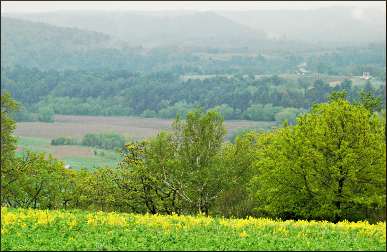
© Torsten Muller
In the coulees of southwest Wisconsin, a lush green zone draws anyone who craves a heady dose of nature.
It starts in spring, when trilliums bloom along Rustic Roads, morel mushrooms pop out on hillsides and water rushes down the crooked Kickapoo River.
It's not close to any city, but people find their way. Norwegians were first to be drawn to its deep, narrow valleys, like miniature fjords.
"People who are from the flatlands sometimes feel claustrophobic here," said Jonel Kiesau of the Kickapoo Valley Reserve near La Farge. "But if you're from this area, you feel hugged and cozy."
The river surges out of a vast watershed around Wilton, on the Elroy-Sparta State Trail. It heads 11 miles south to Ontario, where canoe outfitters launch flotillas of paddlers to Wildcat Mountain State Park.
When they get there, six river miles later, they've paddled in all four directions of the compass.
The river's famously twisting course is dictated by rock — old rock, the skeleton of the continent, with all its bones poking through because none of the last glaciers deposited any sediment to pad them.
Each glacier slid right around this corner of Wisconsin, from the Dells to Dubuque, preserving its pointy hilltops and flat valleys and leaving it without the glacial rubble, or drift, that covers the rest of the region.
Now, this part of Wisconsin is known as the driftless area.
The Kickapoo Valley lies at its heart, and its unusual topography — prairie savannah and marshes, cool valleys and sun-soaked cliffs — make it hospitable to many rare plants and birds and more giant white pines than can be seen anywhere outside the far north.
"It's such a crazy place," said Jessica Bolwahn of the Mississippi Valley Conservancy in La Crosse. "You've got pockets of northern species and pockets of southern species in a really small place."
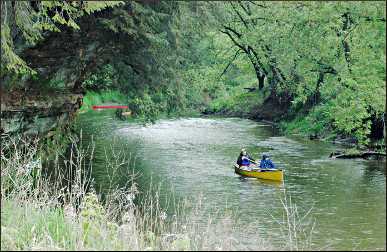
© Torsten Muller
Yet this valley nearly became the sludge-covered bottom of a reservoir. It often flooded — partly because rainwater flowed in from 140 tributaries and off its steep sandstone walls, but also because of clear-cutting and poor farming practices — and the U.S. Army Corps of Engineers decided to build a dam.
It began buying land in 1969, condemning farms when owners resisted. But in 1970, the Environmental Protection Act established requirements the plan couldn't meet. After $18 million was spent and 140 families forced from their homes, the project ground to a halt.
In 2001, the land between Wildcat Mountain State Park and La Farge became the Kickapoo Valley Reserve, jointly owned by the state and the Ho-Chunk Nation.
The Siouan Ho-Chunk, or Winnebago, were the most recent residents, but the river is named for earlier residents, the Kickapoo, an Algonquian nation whose name means "one who moves there, then here."
Now, the 8,569-acre reserve is a green zone for fishing, hiking, canoeing, bicycling and bird watching. Wetlands soak up rainwater and serve as breeding habitat for more than 100 species of birds.
There's a visitor center, with exhibits and a push-button flood table.
In search of birds
One May weekend, we went on a bird walk out of the center with the Wisconsin Society for Ornithology's Barb Duerksen, whose finely tuned ear soon was picking out the calls of an Eastern towhee, a warbling vireo and a blue-gray gnatcatcher.
As a sora called in the distance, Duerksen picked up two stones and clicked them together, calling the marsh bird closer. Once she had done the same thing at the same spot, she said, and "it popped up right at my feet."
"It's a really neat bird to see because it's so shy, and you don't usually get a look at them," she said.
Our trail led to a marsh, where we watched swallows, red-winged blackbirds and two shy coots.
Old Highway 131 leads over the marsh and heads north through the reserve, now a six-mile wilderness trail for bicyclists and hikers. On the other end of the marsh, a covered bridge crosses the Kickapoo, one of 12 bridges in the reserve.
After the bird walk, we decided to hike another section of Old Highway 131, where it hugs the river out of Rockton. The forest has engulfed the old guardrail and crept over its edges, but on a drizzly day, the asphalt road made the best possible trail.
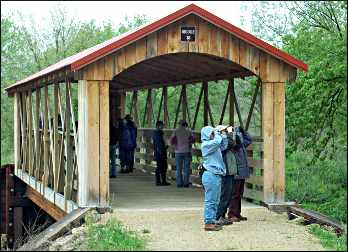
© Torsten Muller
Birds chattered nonstop in the trees, and at the foot of a sandstone cliff, a frog plopped into a puddle and sat there, staring at us. As we walked to the next bridge, we thought how much fun it would be to ride the whole route on a bike.
"It's great, especially for families with younger kids," says Kiesau, the reserve's education coordinator. "It goes through so many habitats."
Ecotourism now is a source of income for people in the valley. So is organic farming, and its hub is just down the road from the visitor center.
On a hillside above La Farge, the headquarters of the Organic Valley cooperative, started in 1988 by seven Kickapoo Valley farmers, now coordinates the output of hundreds of organic farmers in two dozen states but still can't convert farms fast enough to meet demand.
Since the rain didn't let up, we drove 30 miles farther down the valley, admiring the roadside scenery. North of Viola, one green little valley was particularly scenic.
"In Nebraska, that would be a state park," my husband noted.
An apple capital
Our destination was Gays Mills, famous for its apple orchards, which are covered with blossoms in May. It has an inviting main street, too, and at the Village Greenhouse we stopped to buy perennials from pony-tailed proprietor Joe Brandt.
"Organic farming is taking off, which ties in to the hippies," he said. "We've got a lot of 'em here; we have a lot of earthy people."
At Kickapoo Exchange food co-op next door, we bought maple syrup from Laura Negronida, a Chicagoan who came to Gays Mills after trying the back-to-the-land lifestyle in California. The Kickapoo Valley, she said, is blessed by its location, away from highways and big cities.
"It's remote, which most people think of as the edge of somewhere," Negronida said. "This is remote by being in the middle of somewhere; people just kind of go around it."
It was still raining the next day, so we drove the valley's two Rustic Roads.
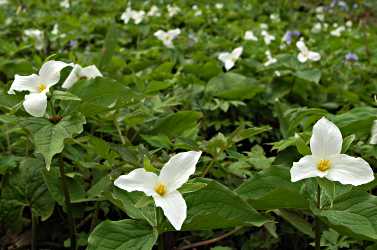
© Torsten Muller
The trilliums had just started to come out on the steep sides of Tunnelville Road, a three-mile channel of vegetation that descends alongside a narrow valley that, through the trees, looked like a river of grass.
Near Rustic Road 55's junction with Wisconsin 131, just south of La Farge, a herd of Texas-style longhorn cattle grazed. We followed the highway north to Rustic Road 56, which climbs a high ridge lined with Amish farms; one was serving as church that Sunday, and there were dozens of buggies parked outside.
At times like these, visitors may feel far from home.
Trip Tips: Kickapoo River Valley in southwest Wisconsin
Getting there: Ontario, in the Upper Kickapoo Valley, is 25 miles south of the junction of interstates 90 and 94 near Tomah and an hour and a half northwest of Madison.
Annual events: Mid-May, Gays Mills Spring Festival. Mid-May, Syttende Mai in Westby, with a bike tour that winds through the Kickapoo Valley. Mid-May, Morel Mushroom Festival in Muscoda. Mid-August, Larryfest outdoor bluegrass festival near La Farge. Mid-September, Driftless Area Art Festival in Soldiers Grove. Late September, Apple Festival in Gays Mills.
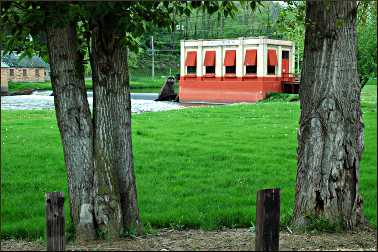
© Torsten Muller
Kickapoo Valley Reserve: Day-use permits are $5. 608-625-2960.
Rustic Roads: Maps can be downloaded.
Canoeing: Three liveries in Ontario offer day trips on the northern part of the Kickapoo River for kayaks or canoes with shuttle: Titanic, 877-438-7865; Mr. Duck's, 608-337-4711; and Drifty's, 608-337-4288. Call in advance to reserve, especially for weekends.
For more, see Chasing the Kickapoo.
Bicycling: The six relatively flat miles on Old Highway 131 through the Kickapoo Valley Reserve can be ridden on all but the thinnest tires. The reserve also has miles of mountain biking, and fit bicyclists can ride on Wisconsin 131, which has a bike lane, and other highways.
The 32-mile Elroy-Sparta State Trail, famous for its three tunnels, goes through Wilton. For more, see Cycling in coulee country.
Hiking: There are many miles of trails in the reserve and in the state park.
Wildflowers: They're easily seen along roads, the river, in the reserve and in two state natural areas: the Tunnelville Cliffs, above the East Branch of the Kickapoo, and Mount Pisgah Hemlock-Hardwoods in Wildcat Mountain State Park.
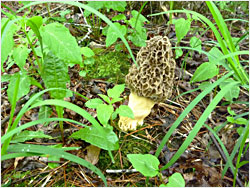
© Jen Oberg
Morel mushrooms: They're abundant but elusive, as they are everywhere; try the reserve or state park. Typically, they peak around Mother's Day.
If you can't find any, buy some at the Viroqua Food Co-op, the Kickapoo Exchange Natural Food Co-op in Gays Mills or at the Morel Mushroom Festival in Muscoda on the Wisconsin River in mid-May.
Accommodations: There are many cabins and cottages for rent, and it's handy to have a kitchen since restaurants are limited.
Kickapoo Valley Ranch rents eight well-appointed cabins.
Two Trillium Country Cottages have views of the countryside on a ridge outside La Farge.
In Soldiers Grove, the renovated 1923 Tobacco Warehouse Inn has six suites, some with kitchens.
Camping: There are 25 primitive campsites in the Kickapoo Valley Reserve. They're first come, first served. Campsites are also available at Wildcat Mountain State Park, 608-337-4775.
In Gays Mills, there's camping in Robb Park next to the Kickapoo. There are flush toilets, and some sites have electricity. 608-735-4341.
Information: Check Driftless Wisconsin, which covers the region, and Hidden Valleys.
For more about the Norwegian area around Westby, round barns and the Amish, see Valleys of Vernon County.